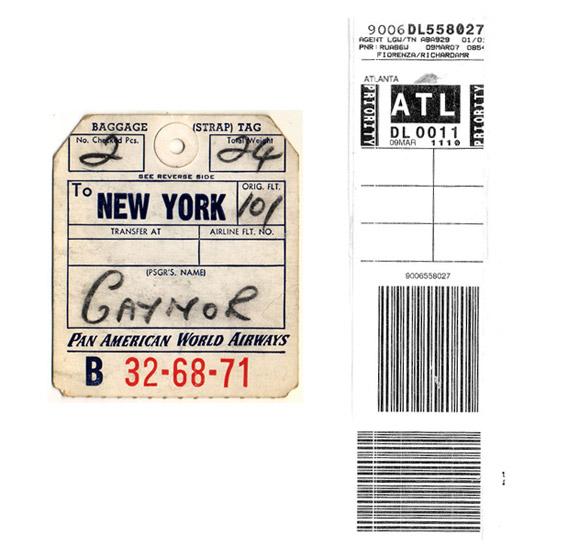
Passengers collect baggage from a carousel at Oakland International Airport in 2011 in Oakland, Calif.
Photo by Justin Sullivan/Getty Images.
The poet Maya Angelou once said you can tell a lot about a person from the way they respond to three things: a rainy day, tangled Christmas lights, and lost luggage.
Maya, Maya. Where were you at 2 a.m. the dark night I arrived in Paris without my bags? I needed my suit for the next morning, not folksy aphorisms or your musings on why the caged bird sings. Personally, I find the caged bird sings most beautifully when he has his laptop charger and toothbrush.
We?ll never know quite how Dr. Angelou would cope with the news that a vacation?s worth of clean underwear has been flown to the wrong Portland. But she?s right to suggest that lost luggage is a near-universal experience. Every frequent traveler will at some point face the drifting tumbleweed on the baggage belt. ?
Still, if most of us have a tale of luggage gone wrong, it?s not because airlines lose a lot of bags. It?s because we fly so much. In July alone, 53 million passengers boarded domestic flights. Only about one-third of 1 percent reported a mishandled bag. Given the phenomenal scale of American aviation (measured in seats and miles, the U.S. market is three times larger than any other) and our reliance on luggage-juggling hub airports, that?s an excellent result. Even caged birds are treated pretty well by modern air travel (though remarkably, they do get airsick): In July, U.S. airlines lost just one pet.
This success is largely due to the humdrum baggage tag. That random sticky strip you rip off your suitcase when you get home? It?s actually a masterpiece of design and engineering. Absent its many innovations, you?d still be able to jet from Anchorage to Abu Dhabi. But your suitcase would be much less likely to meet you there. (Disclosure: I am a pilot for an airline that?s not mentioned in this article.)
First a little history. In the old days?we?re talking steamships?there were two kinds of tags for luggage. Best known are the labels affixed to trunks. Often these were pure advertising for the shipping line, with no room for personal information?for some beautiful examples click here and here. The other kind of tag?a destination tag?was more practical, though still aesthetically pleasing. One side often bore the line?s logo, as in this classic Cunard White Star tag. The reverse held information such as the passenger?s name, destination, stateroom and whether the bag was ?Wanted in Stateroom? or ?Not Wanted on Voyage.?
Early on, airlines offered labels that mimicked maritime-style advertising stickers, with lovely results. But initially, airlines had no need for destination tags: As the International Air Transport Association explained to me, ?a passenger?s chauffeur would drive the passenger to the aircraft side, and stewards would load the passenger?s bags directly from the car to the aircraft.? Nice.
As air travel expanded beyond the perfumed realms of the chauffeured, destination tags became a necessity. Maritime tags were the model, but with the occasional important tweak, as Melissa Keiser, an archivist for the National Air and Space Museum, points out. What is inconsequential to ocean liners and railways, but vital to airlines? Weight. It?s critical that airlines know how much bags weigh, and how they?re distributed around the plane. According to Keiser, a space for weight was commonplace on airline tags by the 1920s. ?Separable? baggage tags, which featured a removable receipt for travelers, had first been developed for railways in 1882 (check out the excellent patent application). By the 1930s, says Keiser, they too had been widely adopted in aviation.
But as aviation grew still further, airline tags shed their maritime and railway heritage. Compare the two tags below: a Pan Am tag from the 1950s, and a modern tag of the sort an airline will put on your bag today.
 At left, a Pan American World Airways baggage tag, and at right, a modern baggage tag
At left, a Pan American World Airways baggage tag, and at right, a modern baggage tagPhotographs courtesy Pan American World Airways/National Air and Space Museum; SITA.
The modern tag is known as an automated baggage tag, and was first tried by many airlines in the early 1990s. Perhaps the earliest airline to implement ABTs system-wide was United, in 1992, according to Jon Barrere, a spokesperson for Print-O-Tape, a tag manufacturer and United?s partner on the project. Let?s examine in detail the myriad improvements offered by the ABT, which symbolize as perfectly as anything air travel?s transition from a rare luxury for the ultra-rich to safe, effective transport for a shrinking planet.
Let?s look first at how an ABT is made. In the interconnected, automated, all-weather world of modern aviation, tags must be resistant to cold, heat, sunlight, ice, oil, and especially moisture. Tags also can?t tear?and crucially, if they?re nicked, they must not tear further?as the bag lurches through mechanized airport baggage systems. And the tag must be flexible, inexpensive, and disposable. Plain old paper can?t begin to meet all these requirements. The winning combination is what IATA?s spokesperson described as a ?complex composite? of silicon and plastic; the only paper in it is in the adhesive backing. ?
Source: http://feeds.slate.com/click.phdo?i=2c2f8eb2e8cb46d37c123bec2d9acc44
daytona 500 start time ryan zimmerman oscars red carpet jennifer lopez wardrobe malfunction hugo hugo nfl combine
No comments:
Post a Comment
Note: Only a member of this blog may post a comment.